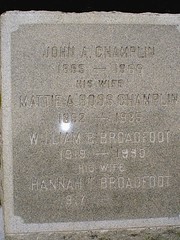This close-up of the granite gravestone of Hannah T. Champlin's husband (my uncle) and parents demonstrates the challenge faced by gravestone photographers hoping to get a readable but visually pleasing photo.
Scott Bill Hirst did a great job even though he had not done this before and was using his first digital camera. [Applause]
Classically, this shows how an inscription added to an existing surface of polished granite can look different. When a date is added later to this stone even that will stand out further. This can help a genealogist determine in what order the stone was inscribed. As you know many people have monuments pre-inscribed with everything except the date of death.
The information added here matches the oral and written history I took many years ago from Hannah. She carefully recorded her name, place and dates and marriage for herself and for her husband.
Next, she recorded her parents names and dates. She wrote that her father's middle name was Almeron. I wondered if it was a family surname or a place but my research has yet to confirm any of these thoughts. She also told me she had a sister and gave me her name. She is a sharp cookie and was very interested in what I was doing and why. That was great for me to hear.
She even shared via snail mail a letter she received from a library in Scotland about the origin of the name Broadfoot. Women are not always interested in their husband's name even though they use it for many years beyond their birth surname! You can see why having a photo of her gravestone was important to me.


No comments:
Post a Comment